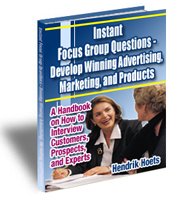How to Write a Focus Group
Moderator Guide
Moderator Guide - Outline for Action
The focus group moderator guide is your interviewing outline. You use it during a focus group or depth interview.
The guide, as its name implies, guides the interview.
The moderator typically writes the guide, which contains topics, questions, and activities for an interview.
A typical guide contains the following:
- Research objectives
- Brief respondent profile
- Where and when interviews take place
- Introduction
- Topics
- Questions and activities
- Close
Research objectives shape the interview topics. Topics contain questions and activities.
Keeps You on Track
The guide keeps the moderator on track.
Experienced, professional moderators use guides. If you are a new moderator, a guide is a necessity.
Writing the guide helps you internalize the questions. It makes you a better moderator. It prepares you for discussion and helps you keep the discussion conversational. It also reminds you of important topics and questions.
Write the moderator guide, and read it several times before you interview. A guide is your script and reference whenever you need it.
A written guide helps sponsors or clients of the research. They review and approve the guide. It minimizes disagreements later.
Clients or sponsors follow the guide during a focus group. If a sponsor is listening and watching a focus group, he or she can follow the interview guide.
The guide is not only a record containing important objectives, topics, and questions, but it serves as a reference for future guides.
The guide prepares you for interviewing. The better prepared you are, the easier interviewing becomes.
Let’s talk about each part of the moderator guide.
Here is how to write each part of the guide.
Research Objectives
Place the research objectives at the beginning of the moderator guide. This will remind you and your sponsors of the purpose of your research.
Respondent Profile
Next, write a brief description of the people you interview. Your screener provides this information. It will remind you of the respondent’s characteristics and give you background and context.
Logistics
Then, for face-to face interviews, write the place, date, and time of the interviews.
For telephone interviews, write the name, title, telephone number, and address of the respondent.
Introduction
Here you introduce yourself to the respondents.
The introduction is important. It sets the tone and starts building rapport.
You tell respondents the general purpose of the interview. You estimate the time of the interview. You also tell respondents what they will be doing, and you remind them of their incentive.
You also tell them their answers will be used for research, remain confidential, and that their names will remain anonymous.
Before the interview, ask permission to record it. In a face-to-face interview, you want respondents’ signed agreement granting permission. In telephone interviews, you get a signed agreement or verbal agreement. Several states require agreements. It’s the law.
In the introduction, include an easy question for the respondent to answer.
For example in a B2B telephone interview you could ask, “Please tell me your job and responsibility.”
In a consumer interview, “Please tell me what brand of [insert category] you use.”
The purpose of the introduction question is to get the respondent talking and feeling comfortable. The introduction builds rapport.
Topics
A typical moderator guide covers three to five major topics. Your research objectives set up your major topics.
- General Topic
- Primary Topic
- Second Topic
- Third Topic
- Fourth Topic
- Close
The general topic starts the conversation and is ideal for building rapport. It gets respondents talking, easing them into conversation.
Some common consumer research topics typically include,
- Awareness
- Product Use
- Buying behavior
- Switching
Note: this list of topics is not exhaustive.
Questions and Activities for Each Topic
The guide includes all the main questions and activities.
Within a topic, you order questions. Logical order improves conversation flow and cut downs bias.
Here is how to do it.
Ask
- General questions before specific questions
- Behavior before attitude questions
- Positive before negative questions
- Unaided before aided questions
- Respondent categories before your categories
General to Specific Questions
You start your topic with broad questions. They get respondents thinking about the topic.
You cast a wide net and see where the respondents take you. You may find topics you had not thought about, but are important. You discover new roads and new objects of interest.
For each topic, start with general, broad questions, then, move to more specific, narrow questions.
As the conversation progresses, ask respondents questions that are more specific.
Typically, interviewing uses open-ended questions.
Behavior before Attitude Questions
Ask behavior questions before attitude questions.
You want respondents to tell their stories about their actions… their behaviors. Past behavior is a fact, and may be an indicator of future behavior.
If respondents talk about attitudes before behaviors, they may change their stories about behaviors. When people say something, they try to appear consistent with their previous statements, even if it means bending the story.
Positive before Negative Questions
Ask positive questions before negative questions.
You don’t want the interview to turn into a gripe session.
For example, start with, “What do you like best about your cell phone?” After you hear the answers ask, “What do dislike most about your cell phone?”
Talk about positives before negatives and keep the conversation balanced.
Unaided before Aided Questions
Don’t put words in people’s mouths. It biases them.
People may not be aware about a brand, but may tell you they are if you tell them the name of the brand first. It happens. People don’t do it on purpose; some people forget.
So, you ask respondents to name brands before you name brands.
“What brands have you heard of?”
Let them tell you, before you tell them.
After you ask unaided questions and exhaust responses, then you ask aided questions.
Respondent Categories before Your Categories
If you are exploring, you want respondents to tell you how they think about the world.
Let respondents name categories, subjects, and dimensions before you do.
For example, “What are the most important things to think about when buying hydraulic oil?”
Again, this is the same principle as unaided before aided. Don’t put words into their mouths or minds.
Timing
Estimate how much time you will spend on each topic and write it down next to each topic in the moderator guide, for example, five minutes, 10 minutes.
The time estimate keeps you on schedule. In the heat of a lively interview, you don’t want to run out of time, and miss important topics.
A typical focus group lasts about 90 minutes. A typical face-to-face depth interview ranges up to 60 minutes. Depth telephone interviews range from 10 to 60 minutes.
Here is an example of 90-minute focus group schedule.
| Topic | Minutes |
|---|
| Introduction | 5 |
| Awareness | 15 |
| Product Use | 20 |
| Buying | 20 |
| Switching | 20 |
| Close | 10 |
| Total | 90 |
Here is an example of a 25-minute telephone interview schedule.
| Topic | Minutes |
|---|
| Introduction | 3 |
| Awareness | 5 |
| Product Use | 5 |
| Buying | 5 |
| Switching | 5 |
| Close | 2 |
| Total | 25 |
The Close
The close wraps up the interview.
Ask two questions at every close.Write them into the moderator guide.
“Is there anything we missed that you would like to talk about?”“What is the most important point we discussed?”
The first question is a catchall; it captures things the moderator did not think about, but which may be important to the respondents.
The second question clarifies what is important to the respondents.
Often these two questions produce extra and surprising knowledge and insight. Often, they open new topics and extend discussion.
After the two questions, close by saying, “We are done. Thank you.”
That’s it. The focus group moderator guide is an important tool, in qualitative research. Use it every time you moderate a group or depth interview.

Instant Focus Group Questions e-book shows you how to integrate research objectives,topics, and focus group questions into the moderator guide.
The e-book is a practical handbook about qualitative marketing research, packed with tips, techniques, and hundreds of questions. Click on the e-book or link to learn more now.
Return to Planning from focus group moderator guide
Return to Home Page






